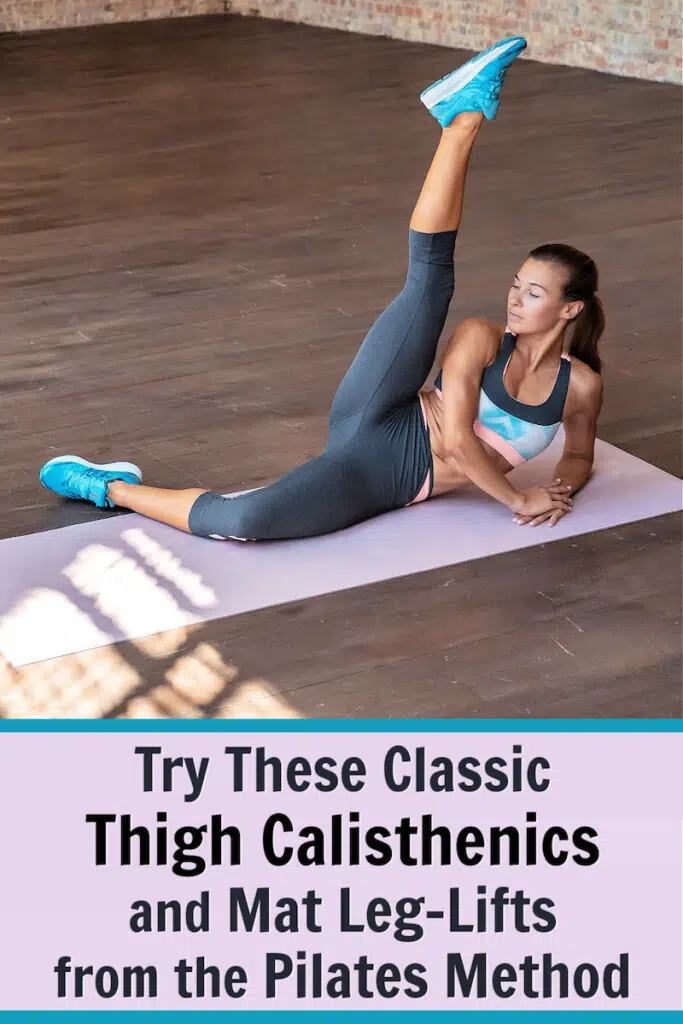Want firmer, healthier thighs? Try Pilates leg calisthenics on the mat. These exercises enhance your appearance, strength, and mobility.
A video is included below, which should prove helpful.
These Leg Lifts Will Sculpt and Tone Your Thighs
Unlock the secrets to healthier, firmer legs with this series of timeless thigh calisthenics and mat leg lifts inspired by the Pilates method.
No equipment is needed – just a bit of determination. Actually, for how fast this workout is, it’s surprisingly effective.
Discover the power of these exercises that were once nearly forgotten but have lately been making their triumphant return to the fitness scene.
The Significance of Robust Leg Strength
Strong legs are an essential asset.
Everyday activities, from walking to climbing stairs and lifting objects, become effortless with well-toned legs:
- Enhance your balance and stability to safeguard against falls and injuries.
- Elevate your athletic prowess and overall physical activity level with a solid foundation of leg strength.
Ultimately, strong thighs translate to optimal health and a sense of well-being.
While it’s true that these leg lifts pack a punch and can supercharge your thigh muscles, they also accomplish something else that’s equally important: they dramatically improve hip mobility.
Elevate Your Health Through Hip Mobility
Rediscovering your hip mobility is crucial, especially as you age.
The Pilates method’s classic leg lifts have a significant role in improving hip joint mobility. This mobility is particularly critical once you cross the threshold of 50.

Experience the freedom of leg movement, performing daily tasks without discomfort or the risk of stumbling.
Furthermore, enhanced hip mobility promotes proper posture and alignment, guarding against musculoskeletal issues and back pain.
Embrace Exercise Variation for a Resilient Lower Body
Go beyond the basics of squats, lunges, and deadlifts for a diversified training regimen.
Resistance training thrives on the principle of exercise variation.
By manipulating variables such as range of motion, sets, equipment, repetitions, rest intervals, and angles, you ignite unique adaptations in density and shape.
Incorporating occasional isolation exercises – like those found in this routine – offers a fresh stimulus to your leg and core muscles, leading to visible and positive results.
Combat workout monotony and continuously challenge your body’s potential.
The funny thing about leg lifts is that they appear easy when someone else is doing them. But if you do them correctly, you’ll soon see they are quite strenuous.
Attain Toned, Sculpted Legs with Thigh Calisthenics
Elevate your lower body’s health and conditioning through purposeful exercises.
These tips will help maximize the effectiveness of your thigh calisthenics routine:
- Beginners can execute 10 repetitions per exercise for each thigh, and intermediate or advanced athletes can do 20.
- Prioritize proper form and controlled breathing.
- Don’t just flop your legs around like wet noodles. Maintain a long body posture, tighten your core, and activate your glutes.
- Keep your legs straight without hyperextending the knees.
- Maintain tautness and imagine your legs as potent energy sources.
One of the advantages of this workout lies in its versatility. It can be performed anywhere – outdoors, indoors, or even in a hotel room while traveling.
Ease into the movements during warm-up to prevent injury.
As your body temperature rises, gradually increase the range of motion and speed.
For a step-by-step visual guide, refer to this instructional video:
- supine single-leg circle (each direction)
- simple forward/back leg swing
- classic leg lift
- small leg circle (each direction)
- inner thigh lift
- double leg lift (oblique)
- side single-leg bike
Joseph Pilates’ Vision of Calisthenics on a Mat
Experience the transformative power of Joseph Pilates’ mat exercises!
Joseph Pilates, the visionary behind the Pilates method, regarded mat exercises – or “Contrology” – as superior to traditional gym equipment.
Developed in the early 20th century, this system stemmed from Pilates’ desire to aid World War I soldiers in their rehabilitation.
These exercises harmonize posture, balance, flexibility, and overall physical fitness. They rectify imbalances within your body and build an enhanced sense of well-being.
You will strengthen your core, refine physical control, and enhance coordination through these Pilates’ exercises:
- By incorporating proper breathing and body alignment, you unlock not only physical benefits but also mental focus and concentration.
- These exercises help you to embrace the mind-body connection and embark on a journey of self-improvement.
Conclusion: Enhance Thigh Strength and Flexibility for Overall Well-being
Unleash your lower body’s potential by embracing Pilates calisthenics.
These exercises are a gateway to enhanced muscular flexibility in the lower body, boasting a multitude of advantages:
- Elevated physical performance and efficiency in physical activities.
- Improved posture and alignment, rectifying poor posture.
- Reduced risk of injury, including lower-back strain.
- Enhanced balance, coordination, and agility.
- Deeper relaxation and stress reduction, promoting overall well-being.
- Increasing lower body flexibility nurtures strength, agility, and confidence in daily tasks.
Revitalize your fitness routine and elevate your well-being through Pilates’ teachings. By engaging in these thigh calisthenics and mat leg lifts, you’ll sculpt a healthier, more robust you from the inside out.
Dive into a journey towards achieving firmer thighs and a more defined booty. Regardless of your gender, these exercises are adaptable to any age or situation.
Additional Sources for Thigh Conditioning:
Variety in Strength Training Is Essential – https://projectsports.nl/en/is-variation-of-movement-important-in-strength-training/
Warm-Up Proven to Reduce Injury – https://pubmed.ncbi.nlm.nih.gov/16679062/
Stronger People Live Longer – https://www.usatoday.com/story/news/health/2022/03/05/health-study-live-longer-30-60-minutes-weight-training-weekly/9389339002/
